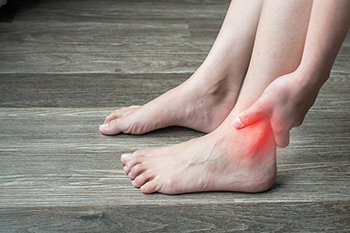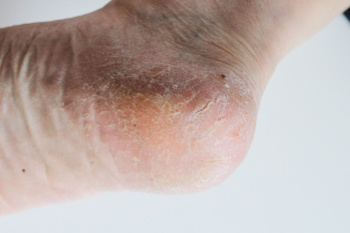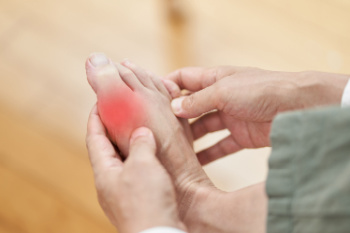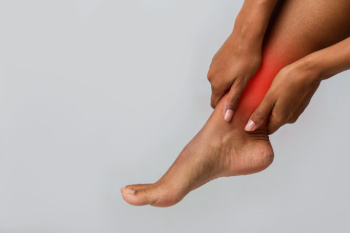

Sinus tarsi syndrome causes ongoing pain and a feeling of instability on the outer side of the foot, just below the ankle. The sinus tarsi is a small, funnel-shaped space in the ankle that contains nerves, ligaments, blood vessels. The sinus tarsi syndrome typically kicks in after repeated ankle sprains or injuries that weaken the supporting structures of the foot. People with sinus tarsi syndrome may feel pain when turning their foot inward or outward. Other symptoms include tenderness when pressing on the area, swelling, and difficulty walking on uneven surfaces like grass or gravel. A foot that rolls too far inward while walking, known as overpronation, can add extra pressure to this part of the foot and increase the pain. A podiatrist can diagnose sinus tarsi syndrome by examining the foot, performing imaging tests, and ruling out other causes of pain. Treatment may include braces or custom orthotics to reduce movement and support the foot properly. If you have symptoms of sinus tarsi syndrome, it is suggested that you schedule an appointment with a podiatrist for an exam and treatment options.
Many people suffer from bouts of heel pain. For more information, contact Dr. Nooshin Zolfaghari of VIP Foot & Ankle Center. Our doctor can provide the care you need to keep you pain-free and on your feet.
Causes of Heel Pain
Heel pain is often associated with plantar fasciitis. The plantar fascia is a band of tissues that extends along the bottom of the foot. A rip or tear in this ligament can cause inflammation of the tissue.
Achilles tendonitis is another cause of heel pain. Inflammation of the Achilles tendon will cause pain from fractures and muscle tearing. Lack of flexibility is also another symptom.
Heel spurs are another cause of pain. When the tissues of the plantar fascia undergo a great deal of stress, it can lead to ligament separation from the heel bone, causing heel spurs.
Why Might Heel Pain Occur?
Treatments
Heel pain should be treated as soon as possible for immediate results. Keeping your feet in a stress-free environment will help. If you suffer from Achilles tendonitis or plantar fasciitis, applying ice will reduce the swelling. Stretching before an exercise like running will help the muscles. Using all these tips will help make heel pain a condition of the past.
If you have any questions please contact our office located in Pembroke Pines, FL . We offer the newest diagnostic and treatment technologies for all your foot and ankle needs.

Cracked heels, also known as heel fissures, can be caused by various factors that affect foot health. Diabetes can lead to poor circulation and dry skin, increasing the risk of cracked heels. Hypothyroidism, a condition where the thyroid does not produce enough hormones, can also cause dry skin and thickened skin around the heels. Skin conditions like psoriasis and eczema can contribute to cracked heels due to dryness and irritation. Fungal infections, such as athlete’s foot, can cause the skin on the feet to peel, crack, and become inflamed. Additionally, a vitamin deficiency, especially in zinc or omega-3 fatty acids, can lead to skin issues, including cracked heels. Keeping feet moisturized, treating underlying health conditions, and practicing proper foot care are essential to prevent and manage cracked heels. Cracked heels can be painful and unsightly. If you have developed this condition, it is suggested that you schedule an appointment with a podiatrist who can successfully treat cracked heels, which often includes prescribed medication.
Cracked heels are unsightly and can cause further damage to your shoes and feet. If you have any concerns, contact Dr. Nooshin Zolfaghari from VIP Foot & Ankle Center. Our doctor can provide the care you need to keep you pain-free and on your feet.
Cracked Heels
Cracked heels appear unappealing and can make it harder for you walk around in sandals. Aside from looking unpleasant, cracked heels can also tear stockings, socks, and wear out your shoes. There are several methods to help restore a cracked heel and prevent further damage.
How Do You Get Them?
Dry skin is the number one culprit in creating cracked heels. Many athletes, walkers, joggers, and even swimmers suffer from cracked heels. Age and skin oil production play a role to getting cracked heels as well.
Promote Healing
Over the counter medicines can help, especially for those that need instant relief or who suffer from chronic dry feet.
Wear Socks – Wearing socks with medicated creams helps lock in moisture.
Moisturizers – Applying both day and night will help alleviate dryness which causes cracking.
Pumice Stones – These exfoliate and remove dead skin, which allows for smoother moisturizer application and better absorption into the skin.
Change in Diet
Eating healthy with a well-balanced diet will give the skin a fresh and radiant look. Your body responds to the kinds of food you ingest. Omega-3 fatty acids and zinc supplements can also revitalize skin tissue.
Most importantly, seek professional help if unsure how to proceed in treating cracked heels. A podiatrist will help you with any questions or information needed.
If you have any questions, please feel free to contact our office located in Pembroke Pines, FL . We offer the newest diagnostic and treatment technologies for all your foot care needs.

Hallux rigidus is a form of arthritis affecting the big toe joint, causing stiffness, pain, and limited motion. Over time, everyday activities like walking or wearing shoes can become difficult. It develops when the joint cartilage wears down, often due to overuse, injury, or abnormal foot structure, leading to inflammation and bone spurs. Risk factors include repetitive stress on the toe, family history, or conditions like gout. A podiatrist diagnoses hallux rigidus through a physical exam and imaging tests like X-rays to assess joint damage. Early stages can be managed with shoe modifications, custom orthotics, and anti-inflammatory medications. Severe cases might require corticosteroid injections or surgery, such as joint fusion or reconstruction. Preventing further damage involves wearing proper footwear and avoiding high-impact activities. If you have big toe pain, it is suggested that you see a podiatrist for a proper diagnosis and treatment.
Toe pain can disrupt your daily activities. If you have any concerns, contact Dr. Nooshin Zolfaghari of VIP Foot & Ankle Center. Our doctor can provide the care you need to keep you pain-free and on your feet.
What Causes Toe Pain?
Most severe toe pain is caused due to a sports injury, trauma from dropping something heavy on the toe, or bumping into something rigid. Other problems can develop over time for various reasons.
Toe pain can be caused by one or more ailments. The most common include:
When to See a Podiatrist
Diagnosis
In many cases the cause of toe pain is obvious, but in others, a podiatrist may want to use more advanced methods to determine the problem. These can range from simple visual inspections and sensation tests to X-rays and MRI scans. Prior medical history, family medical history, and any recent physical traumatic events will all be taken into consideration for a proper diagnosis.
Treatment
Treatments for toe pain and injuries vary and may include shoe inserts, padding, taping, medicines, injections, and in some cases, surgery. If you believe that you have broken a toe, please see a podiatrist as soon as possible.
If you have any questions please feel free to contact our office located in Pembroke Pines, FL . We offer the newest diagnostic tools and technology to treat your foot and ankle needs.

A heel spur is a bony growth that forms on the heel bone, often caused by the buildup of calcium deposits. This condition is closely related to plantar fasciitis, where inflammation occurs in the tissue connecting the heel to the toes. Heel spurs can cause sharp pain, especially when walking or standing for long periods. Osteophytes, the medical term for bone spurs, can develop due to excessive pressure or inflammation in the joints. Exercises for heel spurs aim to stretch and strengthen the muscles in the foot and calf, improving flexibility and reducing tension on the heel. Stretching the Achilles tendon, rolling a frozen water bottle under the foot, and toe stretches can help relieve pain and prevent further damage. If you have heel pain, it is suggested that you schedule an appointment with a podiatrist who can accurately diagnose heel spurs, and offer appropriate treatment solutions.
Heel spurs can be incredibly painful and sometimes may make you unable to participate in physical activities. To get medical care for your heel spurs, contact Dr. Nooshin Zolfaghari from VIP Foot & Ankle Center. Our doctor will do everything possible to treat your condition.
Heels Spurs
Heel spurs are formed by calcium deposits on the back of the foot where the heel is. This can also be caused by small fragments of bone breaking off one section of the foot, attaching onto the back of the foot. Heel spurs can also be bone growth on the back of the foot and may grow in the direction of the arch of the foot.
Older individuals usually suffer from heel spurs and pain sometimes intensifies with age. One of the main condition's spurs are related to is plantar fasciitis.
Pain
The pain associated with spurs is often because of weight placed on the feet. When someone is walking, their entire weight is concentrated on the feet. Bone spurs then have the tendency to affect other bones and tissues around the foot. As the pain continues, the feet will become tender and sensitive over time.
Treatments
There are many ways to treat heel spurs. If one is suffering from heel spurs in conjunction with pain, there are several methods for healing. Medication, surgery, and herbal care are some options.
If you have any questions feel free to contact our office located in Pembroke Pines, FL . We offer the latest in diagnostic and treatment technology to meet your needs.

Ankle pain can result from various causes, with tripping and muscle weakness being significant contributors. Tripping or rolling the ankle during activities like walking or running can lead to sprains or strains, causing pain, swelling, and bruising surrounding the ankle joint. Another key cause of ankle pain is muscle weakness, which can occur from lack of exercise or injury. Weak ankle muscles make it harder to stabilize the joint, increasing the risk of twisting or turning the ankle during daily movements. This instability can also lead to recurring ankle injuries. Symptoms of ankle pain often include localized tenderness, difficulty walking, stiffness, and swelling. If you have ankle pain for any reason, it is suggested that you consult a podiatrist who can determine what the cause is, and offer appropriate treatment solutions.
Ankle pain can be caused by a number of problems and may be potentially serious. If you have ankle pain, consult with Dr. Nooshin Zolfaghari from VIP Foot & Ankle Center. Our doctor will assess your condition and provide you with quality foot and ankle treatment.
Ankle pain is any condition that causes pain in the ankle. Due to the fact that the ankle consists of tendons, muscles, bones, and ligaments, ankle pain can come from a number of different conditions.
Causes
The most common causes of ankle pain include:
Symptoms
Symptoms of ankle injury vary based upon the condition. Pain may include general pain and discomfort, swelling, aching, redness, bruising, burning or stabbing sensations, and/or loss of sensation.
Diagnosis
Due to the wide variety of potential causes of ankle pain, podiatrists will utilize a number of different methods to properly diagnose ankle pain. This can include asking for personal and family medical histories and of any recent injuries. Further diagnosis may include sensation tests, a physical examination, and potentially x-rays or other imaging tests.
Treatment
Just as the range of causes varies widely, so do treatments. Some more common treatments are rest, ice packs, keeping pressure off the foot, orthotics and braces, medication for inflammation and pain, and surgery.
If you have any questions, please feel free to contact our office located in Pembroke Pines, FL . We offer the newest diagnostic and treatment technologies for all your foot care needs.